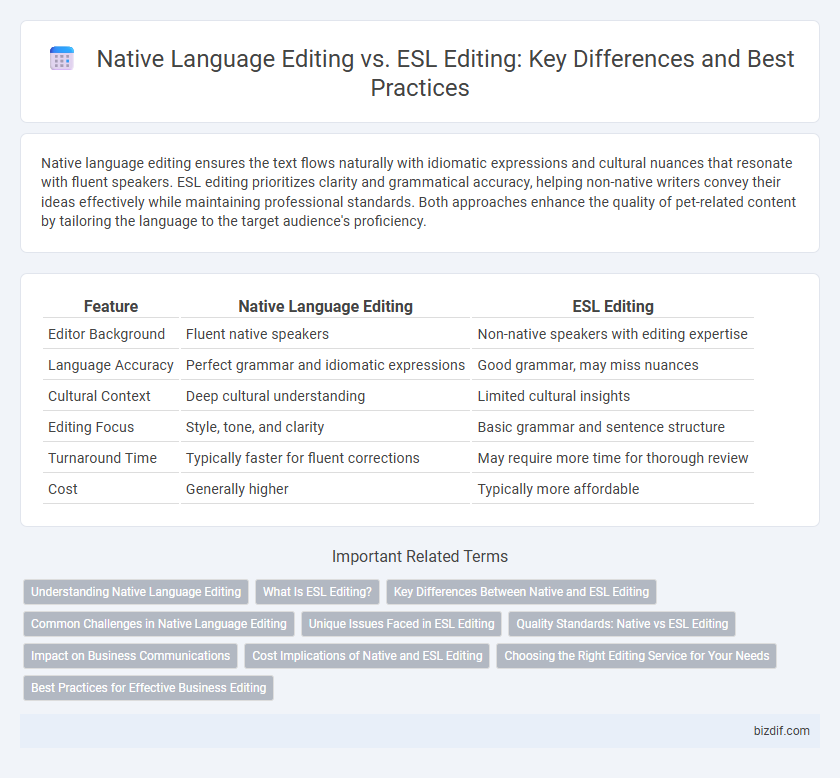Native language editing ensures the text flows naturally with idiomatic expressions and cultural nuances that resonate with fluent speakers. ESL editing prioritizes clarity and grammatical accuracy, helping non-native writers convey their ideas effectively while maintaining professional standards. Both approaches enhance the quality of pet-related content by tailoring the language to the target audience's proficiency.
Table of Comparison
| Feature | Native Language Editing | ESL Editing |
|---|---|---|
| Editor Background | Fluent native speakers | Non-native speakers with editing expertise |
| Language Accuracy | Perfect grammar and idiomatic expressions | Good grammar, may miss nuances |
| Cultural Context | Deep cultural understanding | Limited cultural insights |
| Editing Focus | Style, tone, and clarity | Basic grammar and sentence structure |
| Turnaround Time | Typically faster for fluent corrections | May require more time for thorough review |
| Cost | Generally higher | Typically more affordable |
Understanding Native Language Editing
Native Language Editing involves refining a text written by a native speaker to enhance clarity, tone, and style while preserving the author's original voice. This type of editing focuses on subtle language nuances, idiomatic expressions, and cultural references that are inherently understood by native speakers. Expertise in native language editing ensures the content reads naturally and meets high linguistic standards without altering the intended meaning.
What Is ESL Editing?
ESL editing targets documents written by non-native English speakers, emphasizing clarity, grammar, and natural phrasing to align with native English conventions. This process improves readability and coherence while preserving the author's original voice and intent. Specialized ESL editors possess linguistic expertise to address common challenges faced by writers unfamiliar with English nuances.
Key Differences Between Native and ESL Editing
Native language editing focuses on refining texts written by native speakers, ensuring natural phrasing, idiomatic expressions, and cultural nuances align perfectly with target audiences. ESL editing emphasizes correcting grammar, syntax, and vocabulary for non-native English writers, prioritizing clarity and correctness over stylistic preferences. Understanding these key differences improves the selection of appropriate services to enhance the overall quality and readability of any manuscript.
Common Challenges in Native Language Editing
Common challenges in native language editing include overlooking subtle grammatical nuances, idiomatic expressions, and cultural references that non-native editors may miss. Native editors often face difficulty maintaining objectivity, potentially leading to overcorrection or under-editing based on personal style preferences. Ensuring clarity and coherence while preserving the author's original voice remains a key obstacle in native language editing.
Unique Issues Faced in ESL Editing
ESL editing addresses unique challenges such as grammatical inconsistencies, idiomatic inaccuracies, and cultural nuances that often differ from native language norms. Editors must focus on correcting sentence structure, verb tense, and article usage errors while maintaining the author's intended meaning and voice. Enhanced sensitivity to linguistic diversity and context-specific corrections ensures clarity and coherence in ESL manuscripts.
Quality Standards: Native vs ESL Editing
Native language editing ensures impeccable grammar, idiomatic expressions, and cultural nuances, providing manuscripts with a polished and authentic voice. ESL editing focuses on correcting structural errors, enhancing clarity, and ensuring coherence while respecting the author's original intent. Quality standards for native editing demand a deeper linguistic intuition and stylistic finesse, whereas ESL editing emphasizes error correction and readability improvements.
Impact on Business Communications
Native Language Editing ensures that business communications resonate with cultural nuances and idiomatic expressions, enhancing clarity and professionalism. ESL Editing focuses on correcting language errors and improving readability for non-native speakers, which helps prevent misunderstandings and boosts confidence in international dealings. Both types of editing contribute to more effective and impactful cross-border business interactions, but native editing aligns more closely with brand tone and local market expectations.
Cost Implications of Native and ESL Editing
Native language editing typically incurs higher costs due to the editor's deep understanding of cultural nuances and idiomatic expressions, enhancing text quality and fluency. ESL editing offers a more affordable option by focusing on correcting grammar, syntax, and clarity for non-native speakers, often using standardized rules without cultural adaptations. Choosing between native and ESL editing depends on budget constraints and the desired level of linguistic precision and cultural relevance in the final document.
Choosing the Right Editing Service for Your Needs
Choosing the right editing service depends on your language proficiency and target audience. Native language editing ensures cultural nuances and idiomatic expressions are accurately captured by editors fluent in the language. ESL editing focuses on correcting grammar, syntax, and clarity for non-native speakers, making it ideal for improving technical accuracy and readability without altering the original intent.
Best Practices for Effective Business Editing
Effective business editing requires distinguishing between native language editing and ESL editing to tailor content clarity and coherence appropriately. Native language editing emphasizes stylistic refinement and nuanced language use, while ESL editing prioritizes correcting grammatical errors, syntax, and cultural context to ensure accurate communication. Combining these approaches with consistent terminology checks and reader-focused revisions enhances professionalism and message precision in business documents.
Native Language Editing vs ESL Editing Infographic

 bizdif.com
bizdif.com